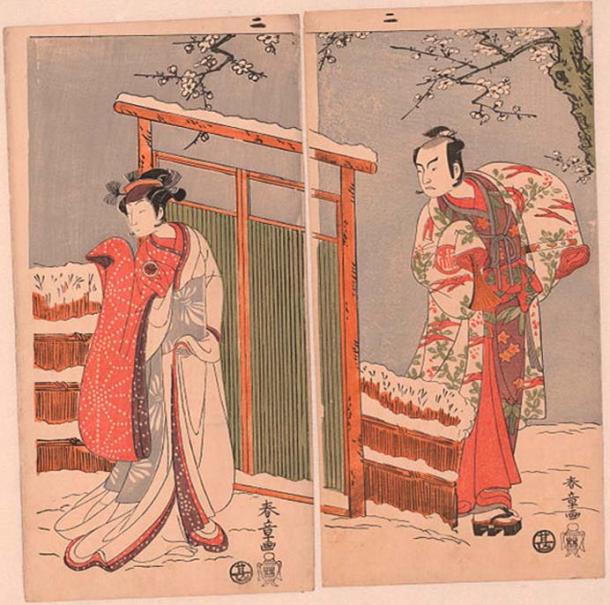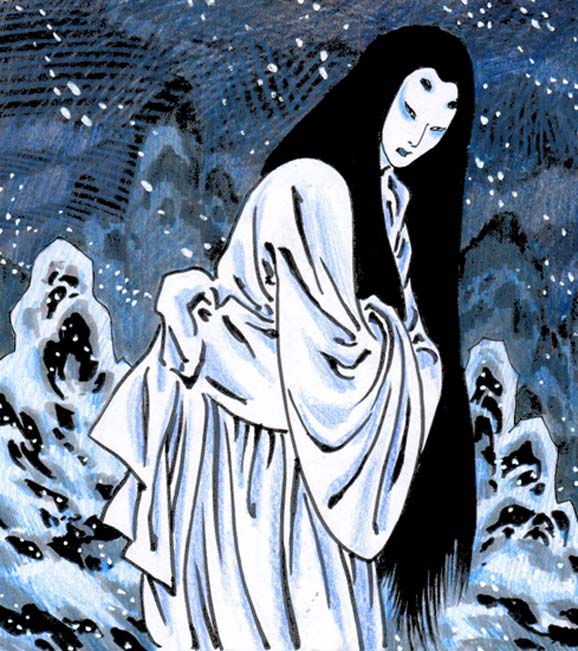
A Heart as Cold as Ice? The Japanese Legend of Yuki-onna, the Beautiful Yet Dangerous Snow Woman
The legend of Yuki-onna (the snow woman) comes from The Land of the Rising Sun. This beautiful but dangerous character may be a personification of death in a severe snow storm. Japanese legends do tend to mention her ability to turn humans to ice. Yet other times, stories speak to her softer, gentler side, and suggest Yuki-onna is more a benevolent snow-spirit than a snowy reaper waiting for her next victim.
Preying on Lost Travelers in the Snow
Yuki-onna is included among the lengthy list of what are known as ‘yokai’ (supernatural creatures known as monsters, demons, spirits or other mythical beings) from Japan. She’s not a very popular mythological creature, but Yuki-onna is known by most people living in the higher altitudes or colder parts of Japan.
For those who are not familiar with the abundant variety of Japanese folklore, yokai make up a substantial part of their mythology and legends. Most unknown phenomena or natural elemental forces could be described as yokai in action.
Yuki-onna is believed to inhabit locations with snowy mountains where she feeds off human life energy and regular food. However, there are variations to this story according to which Japanese province is telling the tale. This means the legend takes a variety of forms which change over time - but a consistent element of the narrative states that Yuki-onna preys on lost travelers in heavy snowstorms. This legend has become better known in the western world thanks to the translated works of Lafcadio Hearn.
- Shinigami: The Grim Reaper of Japanese Folklore
- Beware of the Cat: Tales of the Wicked Japanese Bakeneko and Nekomata – Part 1
- The Allure of Blackened Teeth: A Traditional Japanese Sign of Beauty

1737 depiction of Yuki-onna (the snow woman) from the Hyakkai-Zukan by Sawaki Suushi. (Public Domain)
Yuki-onna’s Appearance
With ageless white skin and cold as ice itself, Yuki-onna is said to have strikingly deep violet eyes and beautiful long black, or white, hair. She feeds on the human life force, sucking it from her victims’ mouths into hers, freezing them solid. Although Yuki-onna can fall in love, marry, and live among humans, she will never age and her identity would eventually be revealed, therefore, most legends say Yuki-onna chooses to stay near mountain roads and prey on travelers.
Among different elements in the Yuki-onna legend, one aspect stands out with much fascination: the time when she appears. As stated earlier, her legend changes according to location. For example, in the Aomori and Iwate prefectures, the Yuki-onna is said to appear during the ‘Koshigatsu’, or ‘little New Years’, which takes place on January 15th as a traditional end of the year festivity for that region. There, folklore says that Yuki-onna would arrive on New Year’s Day and then leave on the first day of February.

1781 depiction of Yuki-onna from the Gazu Hyakki Yakō. (Public Domain)
As Zack Davisson explains:
“The link between these dates and the Yuki-onna is obscure. Some say that in ancient times the Yuki-onna was worshipped as a Toshigami, a special deity that appeared on specific days and brought either good or bad fortune of the coming year. The link with February is interesting, corresponding with the Gaelic festival of Imbolc. She may have been Aomori’s Punxsutawney Phil [a groundhog], either ending winter or extending it with her presence. Some say she may have been a servant to the Mountain God, playing the role of ‘Miko’, or Shrine Maiden, and bringing blessings of fertility and a good harvest. Others say that the Yuki-onna appears only during full moons with new-fallen snow. Mothers in Ehime prefecture are warned not to let their children out to play in such nights. Still others say they arrive and disappear with blizzards. And at least one story says the Yuki-onna appears on the cusp of spring, to bid a temporary farewell to winter.”

Painting of Yuki-onna in the moonlight. (Public Domain)
Legends of Yuki-onna
Although the accounts of Yuki-onna in Japanese folklore are supposedly ancient, the first written records of this being’s story come from the Muromashi period (1333-1573). A monk named Sogi wrote about his personal encounter with Yuki-onna upon leaving his house on a snowy morning. His description spoke of a beautiful, and very tall, young woman standing in his frozen garden with a face as white as snow. Strangely, although young, this beautiful woman’s hair was also white as the snow. She wore a white, almost translucent, kimono - which could not have given any proper insulation for a normal human on a cold snowy day. When Sogi tried speaking to her, the alluring woman vanished. Sogi was told that the Yuki-onna was the Spirit of the Snow, who usually appeared during heavy snowfalls but rarely showed herself at the cusp of spring.

A white-haired Yuki-onna. (CC BY SA)
Other versions of this tale are more frightening, describing the Yuki-onna taking lives of people and as a malevolent spirit. Perhaps one of the most well-known versions of this more chilling story comes from Lafcadio Hearn, who played a very important role in the translation and recording of information about Japanese culture. Hearn’s most famous works include a collection of lectures called Japan: an attempt at interpretation (1904), In Ghostly Japan (1899) (a collection of Japanese ghost and folklore stories), and Kwaidan: Stories and Studios of Strange Things (1904) - which primarily deals with an early interpretation of Japanese culture and customs, including ghost stories.
- Magical Mermaids of Japanese Folklore
- Dragons: Exploring the Ancient Origins of the Mythical Beasts
- Beware the Supernatural Bathroom Spirits, Toilet Deities, and Dung Demons

Middle and right leaf of a triptych from 1770 for the play Myoto giku Izu no Kisewata. The actor Segawa Kikunojo II is in the role of Yuki-onna (left) and actor Arashi Sangoro II is Minamoto no Yoritomo (right). (Public Domain)
In Hearn’s story about Yuki-onna, the legend describes two woodcutters - Mosaku, an older man, and Minokichi, a younger one. The men were going home on a cold evening when they got caught by a heavy snowstorm. They were able to find shelter in a hut close to a river. The two men fell asleep but Minokichi was later awaken by a cold wind, which apparently had blown the hut’s door open. He saw the shocking sight of a woman dressed all in white, bent over Mosaku, blowing her breath upon him.
The Yuki-onna then went towards Minokichi, but she took pity on him when she noted his youth and beauty. She decided to spare his life upon the condition that he would never reveal what he saw that night to anyone. The young man agreed. Yuki-onna also warned him that if he ever told anyone about the event, she would know, and kill him.
A year later, Minokichi married a beautiful young woman named O-yuki (meaning ‘snow’) and they had a happy marriage and children. One day, forgetting about his promise to the supernatural being, Minokichi told his wife about the day he saw Yuki-onna. To his surprise, O-yuki revealed herself to be that same Yuki-onna, and reminded him about his promise of secrecy. She decided to spare Minokichi’s life once again because their children needed to be cared for, but she disappeared, leaving him forever.

A 1910 illustration of Yuki-onna before the young man. (No Known Copyright Restrictions)
A benevolent snow-spirit, a snowy reaper taking lives in heavy snow storms, or a supernatural creature living among humans - whichever version of the tale of Yuki-onna you read, it shall leave you with a different message about this fascinating Japanese folkloric symbol.

Yuki-onna. (Deities Daily)
Top Image: Detail of a modern illustration of Yuki-onna. Source: CC BY SA
By Marina Sohma
References:
Davisson, Z. (2013) Yuki Onna – The Snow Woman. Available at: https://hyakumonogatari.com/2013/12/18/yuki-onna-the-snow-woman/
Hearn, L. (1904) Yuki-onna. Available at: http://www.trussel.com/hearn/yuki.htm
Makino, Y. (1991) Lofcadio Hearn’s “Yuki-Onna” and Baudelaire’s “Les Bienfaits de la Lune.” Available at: http://www.jstor.org/stable/40246790
Meyer, M. (2013) Yuki onna. Available at: http://yokai.com/?s=Yuki
Smith, R.G. (1918) The Snow Ghost. Available at: http://www.sacred-texts.com/shi/atfj/atfj51.htm
















Comments
this one could send chills down one's spine..but still somehow, on the other hand, there is something captivating about it that you jut cannot resist looking more deeply into it..justl ike abouot the legend of kumiho